Hey, just a tip for South America: the rural areas of Corrientes Province in Argentina speak Guarani, though it is difficult to map since most people are bilingual and only speak it at home or in limited context. Also the border areas of both Corrientes and Misiones speak Portuñol: a pigdin Spanish/Portuguese, altough I realize they aren't differentiated in this map. The natives of the western parts of Chaco and Formosa also speak the Guaicuruan language family though they are also bilingual. Unlike Corrientes, where most rural people speak Guarani or at least has loanwords from it regardless of ancestry, there's a sharper differentiation in Chaco and Formosa between natives and criollos (or European inmigrants). While the European descendants speak Spanish almost exclusively, the native Qom people do still speak their own languages asides from Spanish.
Excellent work, though I'm afraid I don't have much more comments.
Thank you so much! Could you take a look at the map I've attached in the post after this one and tell me how it looks?
A little nitpick on the qbam, which looks really good in general
Some Pacific islands (New Caledonia, south-east New Guinea and Vanuatu) have the Romance/Germanic colours (that I guess would be the official languages) when the local languages are widely spoken in these areas.
I was thinking there should be at least stripes of the local languages on these islands, if not removing the foreign ones entirely
Thank you for the compliment. I'd like to address these specifically:
New Caledonia: According to Wikipedia, in 2009, 97.3% of the population reported speaking French, while 58.7% of the people reported having no knowledge of any of the indigenous languages.
Papua New Guinea: Tok Pisin is a widely spoken Germanic-based creole in the urban areas of PNG.
Vanuatu: There is some Romance in Port Vila that is spoken as a first language by some of the upper class population there, but otherwise English and especially Germanic-based creole Bislama are spoken on the islands.
I hope this satisfies.
What are the two languages circled? I can't find proof for the existence of either.
TurkishCapybara is correct on both accounts. The spot in Saudi Arabia is just a remnant of the old Arabic dialects map that I forgot to erase and went unnoticed. I saw it a couple of days ago and fixed it, but I haven't posted anything for a few days.
Also, is there any proof for the existence of Circassian in the middle of Turkey?
From the Wikipedia page:
Wikipedia said:The largest Adyghe-speaking community is in Turkey, spoken by the post Russian–Circassian War (circa 1763–1864) diaspora...
However, it doesn't say where exactly the diaspora is located, so I had to [url="http://www.muturzikin.com/cartesasie/11.htm]trust Muturzikin[/url], which I know can be misleading but Ethnologue seemed to confirm:
Ethnologue said:Central and western Anatolia, Kayseri, Tokat, Karaman Maras, and many other provinces.
Also, if I may comment on your map, empty, it's very nice, and I don't mind the color changes, but it seems you used some sort of "Select by Color" tool, on which you may need to lower the threshold, because many of the colors are too similar to one another. Just to show an example on your map, you've lumped the Berber languages in with Semitic languages.
EDIT: Looking at your map again, I think maybe that was done by design, judging by what you've done with Germanic and Romance languages, but if that's the case, then the label must be "Afroasiatic" rather than "Semitic" because both Semitic and Berber languages are Afroasiatic languages, and Berber languages are not Semitic languages.
Last edited:



